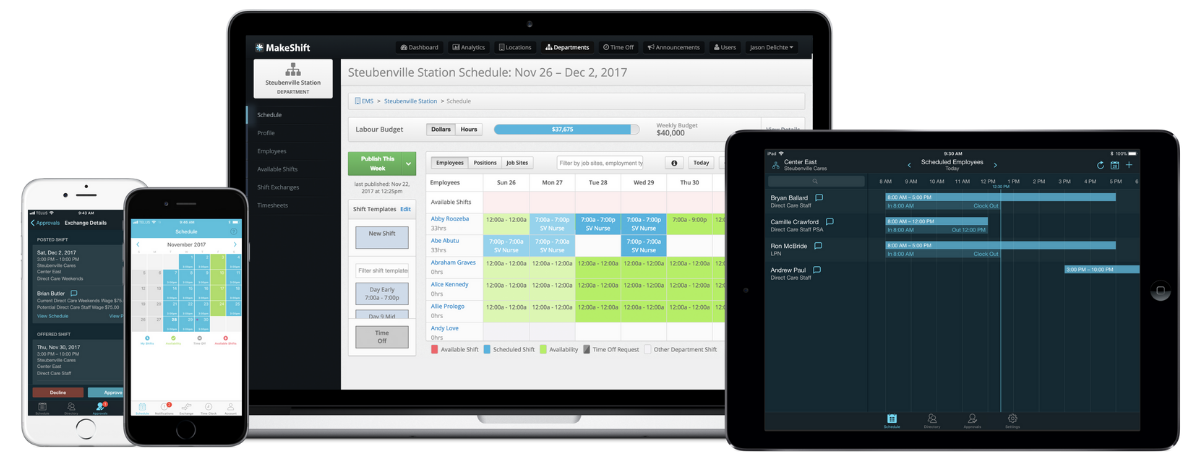The retail industry is known for understaffing, high turnover rates, and unpredictable work schedules.
(It’s no wonder when you try to manage a team of retail employees who work varying shifts and, in some cases, locations.)
Clunky communication causes misunderstandings that wear on employees, who eventually burn out and leave.
Subpar communication doesn’t have to be a retail industry norm.
Try these 9 strategies to improve your internal communication by using innovative tech and upgrading your culture.
- 1. Develop a Solid Communication Plan
- 2. Make “Sticky” Info Easily Accessible
- 3. Use a Single Communication Channel
- 4. Let Employees Use Their Own Phones
- 5. Gather Employee Feedback & Use It
- 6. Be Consistent
- 7. Empower Employees with Tech
- 8. Respect Employees’ Time & Schedules
- 9. Upgrade Your Company Culture
- FAQ
1. Develop a Solid Communication Plan
“Without goals, and plans to reach them, you are like a ship that has set sail with no destination.” – Fitzhugh Dodson
The quality of your internal communications matters.

- 86% of employees and executives cite ineffective collaboration and communication as the leading cause of workplace failures.
- 97% of employees believe communication impacts their daily task efficiency.
Improving internal communication will pay off in terms of happier employees, better customer service, higher productivity, and lower turnover.
However, you should start with a plan to avoid being a ship without a destination. A solid communication plan has 10 key elements:
- Clarity — Define your goals (Ex: Reduce scheduling miscommunication, increase employee engagement…etc.)
- Know your audience — Identify & segment your employees based on roles, departments, and locations.
- Mastered message — Develop core messages and tone of voice (i.e., communication style) that reflect your company’s values, mission, objectives, and vibe.
- Single-flow communication — Decide on 1 communication channel and adopt software to make it accessible to all staff members.
- Pique their interest — Deliver engaging, consistent, and timely updates to keep employees informed and interested.
- Relentless follow-up — Encourage employees to provide feedback, ask questions, and share their thoughts.
- Who does what & when — Designate your communication champions. The individuals responsible for managing internal retail staff communication.
- Build & develop skills — Provide training programs to enhance retail employees’ communication skills, including active listening, clear messaging, and effective use of communication tools.
- Stay in the know — Measure your plan's effectiveness using KPIs like employee engagement scores, communication reach, and scheduling gaps due to miscommunication.
- Crisis plan — Develop a crisis communication plan to effectively handle emergencies and unexpected events.
2. Make “Sticky” Info Easily Accessible
Every organization has its own internal knowledge, or “sticky” information, that all employees grasp over time. Learning how your retail organization does things, for example, the protocol for handling an irate customer or employee break rotations, takes time.
And just because you review this info during the onboarding process doesn’t mean new employees will remember it after hearing it once.
In fact, we’ll bet they won’t remember it.
To help employees learn company protocols and processes faster, create digital documents and training modules for easy, anytime reference.
Simplify communication
New employees may need help with scheduling policies and procedures until they get the hang of things.
Consider using AI-driven scheduling software that can answer scheduling questions whenever they pop up. This type of easily accessible support empowers employees to take ownership of their work schedules.
MakeShift simplifies questions with SmartSupport.

Employees can get their scheduling questions answered 24/7. It responds in real time to queries, provides step-by-step instructions, and offers scheduling tips. It's the support they need whenever they need it.
3. Use a Single Communication Channel
Centralizing communication through a single channel ensures all information is consistent, easily accessible, and not lost across multiple platforms.
Many businesses have already tried to facilitate better communication with social media, but it has hindered more than helped.
Are you using Facebook Messenger, WhatsApp, or texting to handle internal communication?
We get it — you figured you’d use technology to your advantage. Your employees’ phones are practically their 5th appendage, so it makes sense to facilitate communication through their devices.
You’re on the right track.
However, juggling multiple social media DMs to handle shift swap requests, availability, and all other communication brings a whole new set of problems to the scheduling party:
- It’s not professional.
- It lacks oversight.
- Not everyone uses the same platforms, so consistency’s out the window.
- Employees don’t have a way of seeing who’s available for extra shifts.
- Both you and your retail staff end up messaging back and forth in more than 1 app to get scheduling questions answered.
This method can become so chaotic when handling scheduling issues like a last-minute shift change that it’s easier for the employee to not show up to work.
Cut the chaos by streamlining your communication method. It starts with these 2 moves: ⇩
- Choose the right platform — Select a versatile communication tool that suits your retail team's needs, like an all-in-one scheduling and messaging app.
- Be consistent — Encourage your retail team to use the chosen communication channel for all work-related communication. It may take some reminding until your team gets into the habit of using the new channel.
Choose workforce management software that pulls double (or triple) duty
Why choose a separate communication tool when you can elevate workforce optimization with MakeShift?
MakeShift combines scheduling and messaging in one platform, reducing the need for multiple tools and ensuring centralized communications.

Your retail staff can access schedules, updates, and messages all within MakeShift, simplifying communication and reducing the chances of missed information.
4. Let Employees Use Their Own Phones
Allowing employees to use their personal phones for work communication ensures they receive updates promptly and stay connected with the team.
Plus, it’s a trend spreading like butter on a hot biscuit.
82% of organizations currently use Bring Your Own Device (BYOD) options because of the benefits:
- 68% see a productivity boost
- 53% see increased employee satisfaction
- 45% lower overall costs

How do you implement this trend in your retail organization?
- Mobile-friendly tools — Choose communication and scheduling tools optimized for mobile use.
- Bring Your Own Device (BYOD) Policy — Develop a clear BYOD policy that outlines acceptable use and security measures to protect company data.
Choose a communication solution that supports your BYOD policy
MakeShift offers a mobile app that employees can use on their own phones to access schedules, receive notifications, clock in & out, and communicate with the team.

The app includes security features that comply with your company policies, ensuring data is protected while allowing employees to use their own devices.
5. Gather Employee Feedback & Use It
Frontline retail employees have valuable insights into daily operations and potential areas for improvement. Actively seeking and using their feedback leads to better communication and a more efficient workplace.
Try these 2 ideas for gathering feedback:
1. Regular surveys — Conduct regular employee surveys to gather feedback on communication practices, workplace conditions, and operational procedures.
SurveyMonkey is a good tool for this.

2. Suggestion boxes — Anonymous suggestion boxes can encourage honest and constructive feedback without fear of retribution. A suggestion box app is a modern twist on this old-school method.
The data holds the answers
Use MakeShift’s analytics to track scheduling trends based on feedback and identify areas for improvement, ensuring employee input is put into action.
MakeShift goes beyond scheduling — it’s an intelligent workforce management platform that allows you to adapt based on employee feedback.
For example, let’s say you get employee feedback that your retail store is regularly understaffed on the Thursday morning shift (Senior citizens get 25% off).

Ask ShiftPredict to help you forecast your staffing needs for Thursdays based on historical data. Once you’ve got your answer, shoot out an all-team message about upcoming Thursday scheduling changes. Ask your staff to set availability for those who’d like dibs on Thursday morning shifts.
You can do all of this right in MakeShift.
6. Be Consistent
This goes back to your communication plan. Commit to regular internal communication.
This includes:
- Announcements — Roll out weekly announcements on a specific day (this includes sales and any upcoming holidays or events). When your employees know to watch for the “Tuesday Retail Rumble Report” — they’re less likely to miss important announcements.
- Staff schedules — Predictability is numero uno. Post schedules (at least 2 weeks in advance) on a set day. Your staff will be watching for them, which means fewer scheduling miscommunications.
75% of retail workers want a more stable and predictable work schedule.
Choose tools that make consistency a breeze
You know you need to be consistent, so choose tools that set you up for success.
MakeShift allows for streamlined communication through our messaging app.

Schedules are easily accessible on employees’ phones, and they’re automatically notified when new schedules are posted or when schedule changes occur.
The Source, one of Canada’s premier lifestyle retailers, chose MakeShift to help eliminate missed shifts through better communication and employee-powered shift swapping. Implementing MakeShift empowered their employees to cover their own shifts and missed shifts dropped to almost zero.
7. Empower Employees with Tech
Providing employees with top-notch techy tools can significantly enhance communication, streamline operations, and improve overall job satisfaction.
If employees feel they've got tech that supports them at work, they’re 158% more engaged and 61% more likely to stay beyond 3 years in their jobs.

When adopting tech, keep these tips in mind:
- Mobile apps — Don’t bother with solutions without a mobile app. Your retail staff will be more likely to adopt software if they can use their phones.
- Train on tech tools — Offer comprehensive training sessions on using the provided technology efficiently to facilitate communication, scheduling, and task management.
Choose tech that enhances communication
Technology is supposed to make your internal retail communication easier. So make sure you select tech that helps not hinders the process.
For example, MakeShift’s mobile app allows employees to access schedules, receive notifications, and swap shifts from their own devices.

The platform’s intuitive design ensures employees can quickly learn and effectively use the technology, enhancing productivity and communication.
8. Respect Employees’ Time & Schedules
Strong communication regarding scheduling and employee hours shows respect for their time, leading to higher productivity and reliability.
These 2 tips help honor your retail staff:
- Clear scheduling policies — Establish and communicate clear scheduling policies to avoid last-minute changes and ensure fairness.
- Accurate time tracking — Use reliable time-tracking systems to ensure employees are paid accurately and fairly for their hours worked.
Show some R-E-S-P-E-C-T
MakeShift provides real-time updates and notifications about schedule changes, ensuring that employees are always informed and can plan accordingly.

The platform allows for easy management of shift swaps and time-off requests, respecting employees' time and promoting a healthy work-life balance.
9. Upgrade Your Company Culture
Create a company culture of collaboration and open communication. Because implementing a boatload of communication policies, processes, and tools won’t mean a thing if you don’t make that swing [to a better culture].
Focus on these 4 areas to upgrade your culture:
- Lead by example — Ensure retail leadership demonstrates exceptional communication practices. Leaders should be open, approachable, and transparent in their communications.
- Team-building activities — Organize team-building activities that promote collaboration and improve interpersonal relationships among your retail staff.
- Encourage inclusivity — Promote a culture of inclusivity where everyone feels valued and heard, regardless of their role or position.
- Prioritize well-being — Support policies that promote work-life balance, reduce stress, and improve overall communication and morale.
Improving your company culture will profoundly impact your staff’s well-being.
That’s important because retail work can be tough on your employees’ mental health.
The stats say it better than we can:
- 2 out of 5 retail workers say their mental health has declined over the last year.
- 1 in 4 retail workers reported high on-the-job anxiety.
- Over half of retail associates said the benefit they want most is paid mental health days.
- Burnout risk is high — 32.2% of full-time retail workers have another source of income.
- 41% of retail workers say stress from customers has made them cry.
Support well-being & a collaborative vibe through smarter scheduling
Yes, work schedules directly impact your retail staff’s well-being and attitudes toward their jobs and your company.
MakeShift is collaborative by design. A few of our favorite culture-boosting features include:
- Shift swapping — Employees can easily swap shifts, allowing for better management of personal and work commitments and enhancing work-life balance.
- Custom availability — Employees can set availability preferences, helping you create schedules that respect personal needs and promote job satisfaction.
- Self-scheduling — Let employees choose their shifts based on their preferences and availability, increasing job satisfaction and fostering a more engaged workforce.
- Instant notifications — Real-time updates and push notifications keep your retail employees informed of schedule changes, reducing conflicts and improving workflow.
- Team collaboration — Built-in messaging tools facilitate coordination among team members for shift swaps and cover requests, enhancing teamwork and creating a supportive culture.
FAQ
How do you communicate better with staff?
Use concise, direct language to prevent misunderstandings. Active listening is crucial — show that you value their input by listening without interrupting and asking clarifying questions. Foster an approachable atmosphere through open-door policies so staff feel comfortable bringing up issues or ideas.
What communication guidelines would you suggest for a retail business setting?
Keep messages clear, consistent, and on point to avoid confusion and save time.
Regular updates are vital to keep staff informed about any changes, promotions, or important information. Encourage respectful and empathetic communication among staff. Provide a single channel for feedback, promoting a culture where staff can give and receive constructive input.
Retail Staff Communication Doesn’t Have to be Complicated
The retail industry is known for wild fluctuations in foot traffic, high staff turnover, and unpredictable work schedules.
On top of that, communicating with staff working varying hours and at multiple locations can be a muddled mess.
But it doesn’t have to be.
At MakeShift, our people-first approach to scheduling can revolutionize your retail labor management and simplify team communication. Ready to see for yourself?
Sign up for a FREE demo today.








